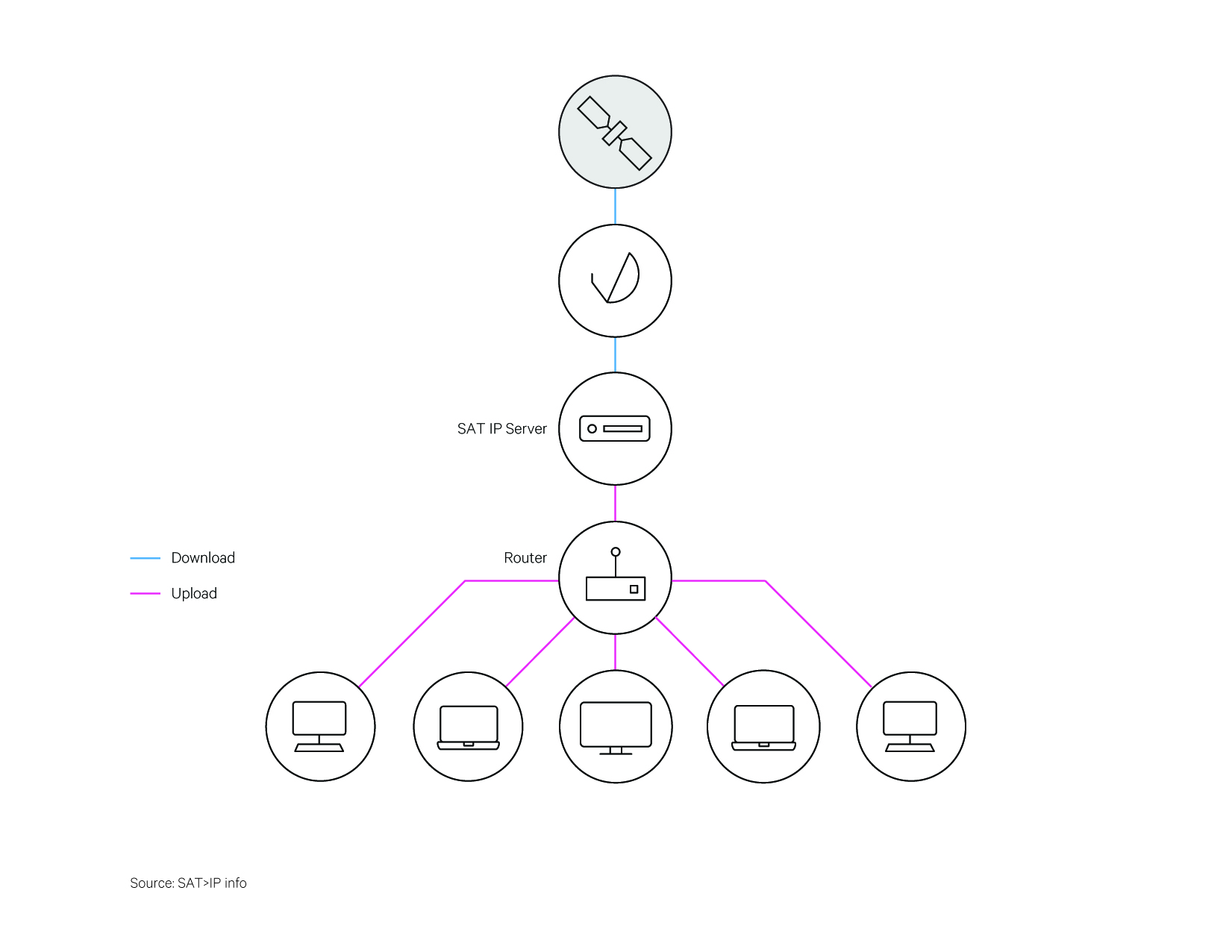The importance of SAT>IP for broadcasters

SAT>IP is set to change how broadcasters meet consumer demand for content in the digital world. This internet protocol (IP)-based architecture is used for receiving and distributing satellite signals. Primarily focused on satellite TV distribution in the home, the technology can also be applied to multi-dwelling and hospitality reception systems.
The move to IP
The shift to IP-based content has seen people rely on more than just their TV sets for a viewing experience. The Deloitte Africa Mobile Consumer Survey 2016 found that mobile devices are the preferred method for watching short videos. And even though long-form content (think series and movies) is less pervasive on mobile, the consultancy believes this can mostly be ascribed to high data costs and the discomfort of lengthy watching on smaller screens. However, as Wi-Fi networks become more pervasive (both in public areas and inside the home) and form factors change to meet a variety of consumer requirements, this is expected to change.

Source: Deloitte Africa Mobile Consumer Survey 2016
The impact video is having on IP usage cannot be ignored. According to the Cisco Visual Networking Index, global IP traffic will reach 3.3 Zettabytes (ZB) per year by 2021 up from 1.2 ZB in 2016. To put this number in context, Cisco analyst Shruti Jain writes that if each Terabyte in a Zettabyte were a kilometre, it would be the equivalent to 1,300 round trips to the moon and back. American linguist Mark Liberman calculated that the storage requirements for all human speech ever spoken would amount to 42 ZB if digitised as 16 kHz 16-bit audio.
The Cisco study also found that it would take an individual more than five million years to watch the amount of video that will cross global IP networks each month in 2021. In fact, it estimates that by that year every second will see one million minutes of video content cross the global IP network.
IHS Screen Digest conducted research on behalf of SES that shows just how many more connected devices are now being used in the household. In 2008, there were on average 2.2 connected devices per household in developed markets. This number was projected to grow to 6.5 by the end of 2017. The predictions for growth of connected devices in emerging markets are even more dramatic. In 2008, the per-household average was 0.5, and this is set to rise to 3.5 connected devices in 2017.
SES identified this trend and started working on the SAT>IP solution to integrate the advantages offered by satellite video content distribution with the demands of video consumers. This hybrid network brings the best of both satellite transmission to the home and IP distribution in the home.
Defining SAT>IP
SES, UK broadcaster BSkyB, and Danish TV software company Craftwork jointly developed the SAT>IP protocol that was standardised in January 2015. However, it remains a license-free technology available to all manufacturers.
SAT>IP allows the satellite TV distribution to share a data network and enables display and viewing of the signals on any multimedia IP device equipped with suitable software. Multiple SAT>IP servers and clients can operate on the same network with both free-to-air and encrypted pay TV transmissions.
With SAT>IP, satellite-delivered DVB-S/S2 RF signals are demodulated and converted towards IP, right at the point of reception in a SAT>IP device. This lets an entire household, linked to a satellite reception antenna, view TV programmes on tablets, desktop computers, laptops, smartphones, connected TVs, game consoles, and media players.
Viewers can enjoy high quality satellite TV even on devices that are not equipped with their own tuners. Satellite signals can be transferred over any IP infrastructure, with or without cable. This technology also substantially simplifies the distribution of satellite signals to multiple TV sets and IP enabled devices.
How SAT>IP works
SAT>IP is an IP-based architecture for the reception and distribution of satellite signals. Traditional satellite receivers (DVB-S) only translate signals into frequencies before they are forwarded over coaxial cable. Satellite receivers are required to receive and demodulate satellite signals. In SAT>IP technology, DVB-S/DVB-S2 signals are directly demodulated and converted to IP at the reception point in a SAT>IP server.
This can take place directly in the antenna, (IP-LNB), directly after it in the distribution line (SAT>IP multi-switch or converter) or in a master set-top box. Essentially, the SAT>IP server replaces the DVB-S/DVBS-2 layer with an IP transport layer. Following conversion, satellite programmes can be transported to SAT>IP clients over a router and different IP networks (e.g. WLAN, Ethernet, Power Line, fibre optic cable or LAN) just like conventional IPTV signals are.
This allows simultaneous transmission of up to eight TV programmes to different end-user devices. SAT>IP distinguishes between servers and clients. The new, open, manufacturer-independent protocol ensures that SAT>IP clients can communicate with SAT>IP servers.

Source: SAT>IP Info
What SAT>IP means for broadcasters
With SAT>IP making it possible to distribute satellite TV services in an efficient way to any device connected to a domestic IP network, the potential this provides broadcasters across the continent is immense.
Because communicating in a direct relationship with consumers, even when they are not in front of their TV sets, is the best way to engage new viewers, keep them loyal, and monetise investments in programme acquisition and content making, SAT>IP provides the ideal mechanism to accomplish this. Any broadcaster wants to accomplish brand ‘stickiness’ by connecting with its audience for more hours during the day as it provides for more marketing and revenue opportunities. Being able to use multiple devices in an IP environment means the broadcaster can drive cross-platform promotions across its programming and embrace the features of each device more fully.
To successfully achieve this enhanced and extended bonding with viewers, many different kinds of content need to be produced, formatted, and seamlessly delivered to be viewed on screens of all sizes. This often involves several different technology standards and networking technologies. Critical to the success is the picture and sound quality, service reliability, and look and feel which must combine for a smooth user experience.
Broadcasters clearly still have some way to go to achieve this goal. According to the Accenture Video Solutions Survey 2013, when asked to rate the consistency and quality of experience when accessing video services across devices, only 45 percent of consumers indicated they are satisfied (see illustration below).

Source: Accenture Video Solutions Survey 2013. Rate of satisfaction of consistency and quality of experience across various devices
Moreover, the viewer experience must be of the highest quality regardless of location in the house, the device used, or the type of media consumed. Then there are contributory factors beyond the broadcaster’s control to consider as well. For example, picture quality in a broadband environment is not guaranteed. Transmission of high-quality programming, including live TV, and distributing it around the home to assorted devices requires significant bandwidth that must be reliable, of the right signal quality, and transferred over infrastructure robust enough to support it.
The problem the broadcaster faces is how to seamlessly deliver video content to these range of devices scattered throughout the home with the only commonality between them is having an IP connection. SES understands these challenges and developed the SAT>IP technology to reach viewers anywhere in the home on any device they use. More importantly, this is delivered without being connected to the internet.
SES has been able to do this by leveraging its world-class state-of-the-art satellite fleet, worldwide terrestrial resources, and industry standard-setting expertise, while employing reliable and robust complementary technologies such as IP to develop this innovative solution.
The benefits of SAT>IP
With SAT>IP, viewers can enjoy the freedom of watching their favourite content on any screen in the home that has IP connectivity. It provides the standard that solves the problem of how to get content disseminated throughout the home to the multiple devices being used – critically, without overloading the internal broadband network, and ensuring that there is no diminishment in picture quality.

Source: SAT>IP Info
SAT>IP is truly the bandwidth-efficient way to seamlessly deliver content around the home. It is a plug-and-play solution that helps broadcasters build a stronger relationship with customers by serving high-quality content on any IP-enabled device.
It relies on tried and trusted technologies and uses the high capacity, highly reliable satellite fleet of SES and globally accepted IP networking to provide broadcasters with a unique selling proposition that no other alternative network technology can provide today.




